Citation: Taylor, G. J. (June, 2018) Meteorite Evidence for a Complicated Protoplanetary Disk, PSRD, http://www.psrd.hawaii.edu/June18/complicated-disk.html.
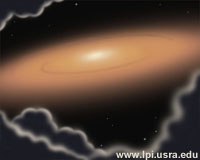
|
June 14, 2018
Meteorite Evidence for a Complicated Protoplanetary Disk
--- A striking dichotomy in isotopic compositions of meteorite groups appears to be consistent with Jupiter and Saturn migrating to and fro during planet formation.
Written by G. Jeffrey Taylor
Hawai'i Institute of Geophysics and Planetology
As shown originally in 2011 by Paul Warren (University of California, Los Angeles), the isotopic compositions of elements such as oxygen, chromium, and titanium in planetary materials fall into two distinct groups. One group is composed of most differentiated (melted) meteorites (and hence the asteroids they come from), non-carbonaceous chondrites, Earth, Moon, and Mars. The other is composed of carbonaceous chondrites, most with significant water contents, and a small fraction of differentiated meteorites. Edward Scott and Alexander Krot at the University of Hawai‘i, and Ian Sanders at Trinity College, Dublin, Ireland, have explored this fascinating isotopic dichotomy, with emphasis on the abundance and isotopic compositions of the components making up the chondrites in each group. Their work also bears on the record of impact mixing in asteroids such as 2008 TC3, which was observed to blaze through Earth's atmosphere to give rise to hundreds of meteorites (collectively called Almahata Sitta) observed to fall in the Nubian desert of Sudan, in the parent body of the Kaidun meteorite that fell in South Yemen in 1980, and in the existence of iron meteorites and tens of metallic asteroids that are missing the associated silicates that would have overlain metallic cores. Taken together, the observations are consistent with rapid growth of Jupiter that isolated inner and outer Solar System objects, preserving and partly creating the dichotomy, followed by Jupiter and Saturn drifting inwards and then outwards (called the Grand Tack model), which populated the asteroid belt with bodies representing the two isotopically-defined groups. This to and fro migration also led to collisions, creating the complex asteroids that gave rise to Almahata Sitta and Kaidun.
Reference:
- Scott, E. R. D., Krot, A. K., and Sanders, I. S. (2018) Isotopic Dichotomy Among Meteorites and its Bearing on the Protoplanetary Disk, The Astrophysical Journal, v. 854, doi: 10.3847/1538-4357/aaa5a5. [ article ]
- PSRDpresents: Meteorite Evidence for a Complicated Protoplanetary Disk --Short Slide Summary (with accompanying notes).
Large-Scale View of the Isotopic Dichotomy
The diagram below is a modified version of one of the diagrams shown by Paul Warren in his 2011 paper. No need for the sophisticated statistical analysis to see that there are two distinct groups of materials on this diagram of titanium and chromium isotopic compositions. One group is composed of carbonaceous chondrites whereas the other group contains non-carbonaceous chondrites, differentiated meteorites such as the HED meteorites from asteroid 4 Vesta, and Mars, the Moon, and Earth. However, the carbonaceous chondrite group is not devoid of differentiated materials. Thomas Kruijer and colleagues showed in 2017 by analysis of molybdenum isotopes that several groups of iron meteorites are associated with the carbonaceous chondrites (see PSRD article: Meteorite Formation Times and the Age of Jupiter). Because carbonaceous chondrites contain much more water than do any of the objects in the non-carbonaceous group (even much more than Earth, despite oceans covering three-quarters of its surface) it might be tempting to conclude that the carbonaceous group formed in the outer Solar System beyond the frost line (the region where ice is present along with dust) while the non-carbonaceous group formed in the inner Solar System. This may be right (see below), but not all the carbonaceous chondrites contain much water and it is not known how much water was in the asteroids that differentiated to form the iron meteorites associated with the carbonaceous chondrites.

|
| Plot of the epsilon values (ε) for titanium-50 (50Ti) versus chromium-54 (54Cr) in numerous asteroidal meteorites, Martian meteorites, lunar samples, and Earth rocks. The epsilon value is 50Ti/47Ti in a sample divided by 50Ti/47Ti in a terrestrial standard, expressed in parts per ten thousand; it shows the deviation from Earth values. Similarly, ε54Cr is the 54Cr/52Cr ratio in a sample divided by this ratio in a terrestrial standard, also expressed in parts per ten thousand. The carbonaceous chondrites and NWA 011 are distinctly enriched in both ε50Ti and ε54Cr compared to the non-carbonaceous chondrites, several types of igneous meteorites, and samples from Mars, the Moon, and Earth. This clustering may represent formation in the inner versus outer Solar System. |
The important point is that there were two distinctive isotopic reservoirs of materials in the early Solar System. The isotopic variations reflect element-forming processes in supernovae and other processes in dying stars. Studies of tiny (nanometers to a few micrometers in size) presolar grains in meteorites indicate wide variations in isotopic compositions, much larger than the differences between the two isotopic reservoirs identified in the figure above. See, for example, PSRD article: Supernova Confetti in Meteorites. In principle, thermal (or physical) processing of disk solids that retained some memory of the presolar grain isotopic variations could lead to the formation of two distinctive populations.
Small-Scale View of the Isotopic Dichotomy
Ed Scott and colleagues draw attention to the well-known variation in oxygen isotopic composition among the primitive components in CR carbonaceous chondrites, which are the least metamorphosed and altered chondrites. The diagram below shows the ratio of oxygen-17 to oxygen-16 versus the ratio of oxygen-18 to oxygen-16 in parts per thousand. The line labeled TF is where terrestrial samples plot; its slope is determined by oxygen exchange between minerals. Separated chondrules, calcium-aluminum-rich inclusions (CAIs), and amoeboid olivine aggregates (AOA), the major components of chondrites, plot in separate places on the diagram, but on the same line (labeled PCM) that indicates mixing with different amounts of a component with oxygen isotopic compositions like the Sun, which is shown by (what else?) the star in the diagram. It is significant that the chondrules in CR chondrites scatter down the slope 1 line. In contrast, chondrules in ordinary and enstatite chondrites (not shown) scatter near the TF line. This is consistent with formation of the carbonaceous dichotomy group in a region where 16O-rich refractory materials and 16O-poor water were more abundant than elsewhere. Scott and collaborators suggest that this region was beyond Jupiter.
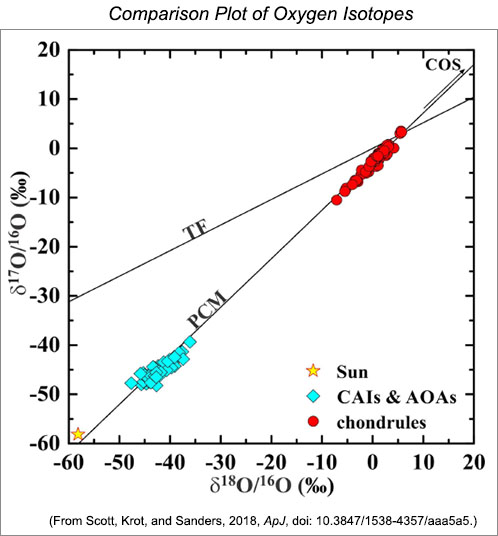
|
| Plot of oxygen isotopic ratios (17O/16O vs 18O/16O in parts per thousand) in primitive components, namely chondrules and CAIs and AOAs, in the CR group of carbonaceous chondrites. The CAIs and AOAs contain significantly more 16O (hence lowering both ratios) than do chondrules. The TF line shows the terrestrial fractionation line, on which all terrestrial samples plot. Chondrules plot close to that line, but CAIs and AOAs are much richer in 16O, plotting not far from the isotopic composition of the Sun, as determined from analyses of samples returned by NASA's Genesis mission (see PSRD article: New View of Gas and Dust in the Solar Nebula). |
CAIs are particularly instructive. They are almost certainly the refractory residue of strong heating in the protoplanetary disk, probably near the growing Sun. However, they do not all remain near the Sun. Samples of Comet 81P/Wild 2 collected during NASA's Stardust mission and studies of interplanetary dust particles thought to come from comets show that minerals derived from CAIs are common in them. Considering that comets formed in the coldest regions of the outer Solar System, CAIs must have been transported from the inner to the outer reaches of the protoplanetary disk. For a case study of one CAI's travels, see PSRD article: A Traveling CAI.
If CAIs (and in fact chondrules, too, see PSRD article: Chronical of a Chondrule's Travels) traveled from the inner to the outer parts of the protoplanetary disk, what was the transportation system? Trains, planes, and automobiles are not likely. More promising is a process called "disk winds," depicted in the diagram below. Disk winds appear to be an important mechanism for removing angular momentum, an important problem in rotating systems. Dust and gas continue to move inwards along the mid-plane of the disk, while the disk winds move materials up and outwards. Observations by the Atacama Large Millimeter/submillimeter Array (ALMA) in Chile document that such motions occur, where wind velocities exceed five kilometers/second near the inner edge of the disk (for more information see paper by P. Bjerkeli and coworkers). The process appears strong enough to transport high-temperature products from the inner Solar System to the frigid places where comets formed. However, it is possible that chondrules are not transported by the stellar winds. Chondrules might have accreted where they formed. The issue of chondrule transport versus in-place formation needs additional research.
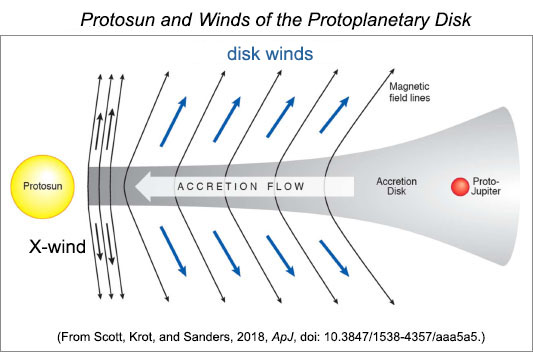
|
| Schematic showing the protoplanetary disk surrounding the young Sun. Two kinds of gas/dust mass outflows are required to carry CAIs to the cold outer parts of the disk: X-winds and disk winds. Observations of other protoplanetary disks by ALMA (Atacama Large Millimeter/submillimeter Array, in Chile) are consistent with the disk-winds concept. Proto-Jupiter (the giant planet's initial rocky core with a mass of 15–20 Earth masses) is shown in the outer part of the accretion disk to emphasize that its existence could inhibit transport from the outer to the inner disk (more on this below). |
Jupiter Blocking
Two observations need to be explained, the existence of two markedly different isotopic reservoirs and the mingling of materials from each reservoir among meteorite parent bodies now occupying the asteroid belt. Distinct but mixed? Sounds impossible, but imaginative ideas suggest otherwise. The solution may lie in formation of Jupiter's rocky embryo, the result of rapid early accretion that would lead to rapid growth of ices and gases to form the gas giant we know so well. Thomas Kruijer and colleagues (see PSRD article: Meteorite Formation Times and the Age of Jupiter) suggest on the basis of their results on core formation times for iron meteorites that fall into the two isotopic groups, combined with published models for the formation of Jupiter, that the dichotomy resulted from Jupiter's formation. Kruijer and colleagues suggest that the rapid accretion of Jupiter's solid core created a gap in the disk that disrupted the inward flow. Once Jupiter reached this critical mass it was large enough to prevent inward transport of solids, thereby separating the inner reservoir (NC) from the outer (beyond Jupiter) reservoir (CC).
Besides blocking transport in the disk from the outer to inner Solar System, Jupiter, with help from Saturn, began to move inwards, due to their gravitational interaction with the gaseous disk. As it migrated, Jupiter scattered planetesimals and mixed things up. Eventually, Saturn's size reached a point where it too migrated inwards and reached a resonance position behind Jupiter when both planets reversed course and migrated outwards, eventually stabilizing near their current orbits, a dynamic model called the Grand Tack by Kevin Walsh (Southwest Research Institute, Boulder) and colleagues in a paper in 2012. As a result, bodies from both the CC and NC reservoirs ended up in the asteroid belt.
Mixed up Meteorites and Asteroids: Evidence for Migration
The Jupiter migrating story helps explain the dichotomy in isotopes observed in meteorites. It also explains the absence of a big rocky planet in the asteroid belt and the relatively small size of Mars. But is there more evidence of the effects of the to-and-fro dance that Jupiter and Saturn might have done? The scattering done by the migrating, accreting gas giants would have been messy. Many scattered objects would have hit one another, perhaps leading to their conversion over time to dust, but also quite possibly leading to creation of crazy mixed-up objects composed of more than one meteorite group.
Do we have any samples of objects with mixed heritage? As Ed Scott and colleagues point out, yes, we do. Here are two cases. The most prominent example is the tiny (about four meters across) asteroid 2008 TC3, which conveniently fell to Earth in 2008, strewing about 700 individual stones across the Nubian desert in Sudan, Africa. The collection has the name Almahata Sitta [Meteoritical Database link]. (See PSRD article: Asteroid, Meteor, Meteorite.) Each stone is composed of only one rock type. Most are a type of ureilite, but numerous samples are chondrites and differentiated rocks, some of which are themselves mixtures. Lots of impacts were involved in the evolution of this asteroid! An illustrative cartoon depicting the formation of Almahata Sitta (drawn by Jason Harrin of the Johnson Space Center) is shown below.
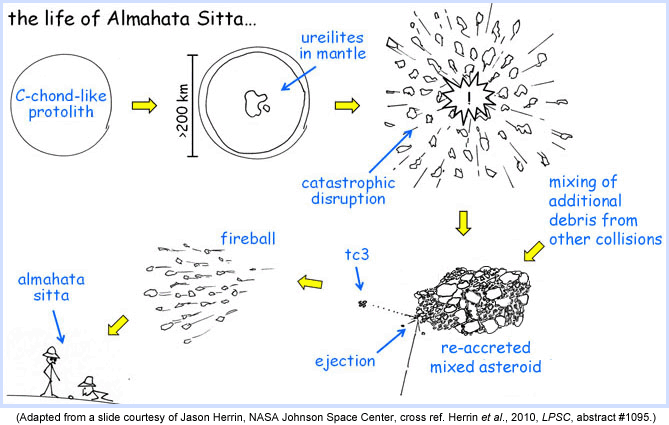 |
| This illustration shows a possible story of the origin of the Almahata Sitta meteorites, adapted from an LPSC presentation in 2010 by Jason Herrin (NASA Johnson Space Center) and colleagues [ abstract #1095]. Follow the arrows clockwise from the upper left. Based on the lithologies observed in the numerous meteorites recovered, researchers propose that the story begins with a carbonaceous-chondrite-like parent body that was heated and partially melted. This hot body was smashed to smithereens by a major impact and the wreckage cooled and was mixed with debris from other asteroidal collisions. The re-accreted debris assembled into a rubble pile of all sorts of materials, with a regolith accumulated on its surface. Further impacts ejected debris off this rubble pile, sending our asteroid 2008 TC3 careening through space and eventually through Earth's atmosphere where it broke apart and scattered itself in the Nubian Desert. Such a complicated history is consistent with scattering of planetesimals by Jupiter's to-and-fro migration in the early Solar System. |
Another excellent example of impact mixing between planetesimals is the meteorite Kaidun [Meteoritical Database link]. (See PSRD article: Kaidun–A Meteorite with Everything but the Kitchen Sink.) It is composed of a variety of chondritic and achondritic meteorite fragments. Bulk Kaidun samples most closely resemble CR chondrites, but the matrix is more akin to CIs and the clast lithologies are of such disparate types that it is clear the fragments formed in many different bodies or conditions and assembled ultimately into the Kaidun parent body whose history cosmochemists are trying to unravel.
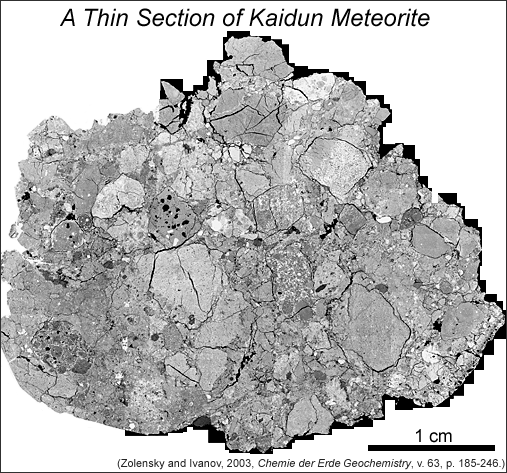 |
| This backscattered electron image of one thin section of the Kaidun breccia meteorite reveals the complex mixture of millimeter-sized clasts of diverse compositions and textures. |
The formative years of the Solar System were not gentle. As PSRD noted in a previous article, Carlé Pieters' (Brown University) poem about the Moon, published in Origin of the Moon, has a particularly appropriate line that reads, "Moon holds secrets of ages past when planets dueled for space." It is not only the Moon that holds the secrets. So do mixed-up asteroids and isotopic dichotomies.
- PSRDpresents: Meteorite Evidence for a Complicated Protoplanetary Disk -- Short Slide Summary (with accompanying notes).
- Bjerkeli, P., van der Wiel, M. H. D., Harsono, D., Ramsey, J. P., and Jørgensen, J. K. (2016) Resolved Images of a Protostellar Outflow Driven by an Extended Disk Wind, Nature, v. 540, p. 406-409, doi: 10.1038/nature20600. [ article ]
- Origin of the Moon (1986) W. K. Hartmann, R. J. Phillips, G. J. Taylor (eds.), Lunar and Planetary Institute, 781 p. [ read at NASA ADS ]
- Scott, E. R. D., Krot, A. K., and Sanders, I. S. (2018) Isotopic Dichotomy Among Meteorites and its Bearing on the Protoplanetary Disk, The Astrophysical Journal, v. 854, doi: 10.3847/1538-4357/aaa5a5. [ article ]
- Walsh, K. J., Morbidelli, A., Raymond, S. N., O'Brien, D. P., and Mandell, A. M. (2012) Populating the Asteroid Belt from Two Parent Source Regions Due to the Migration of Giant Planets–"The Grand Tack," Meteoritics & Planetary Science, v. 47(12), p. 1941-1947, doi: 10.1111/j.1945-5100.2012.01418.x. [ article ]
- Warren, P. H. (2011) Stable-isotopic Anomalies and the Accretionary Assemblage of the Earth and Mars: A Subordinate Role for Carbonaceous Chondrites, Earth and Planetary Science Letters, v. 311, p. 93-100, doi: 10.1016/j.epsl.2011.08.047. [ article ]
- Zolensky, M. and Ivanov, A. (2003) The Kaidun Microbreccia Meteorite: A Harvest from the Inner and Outer Asteroid Belt. Chemie der Erde Geochemistry, v. 63, p. 185-246, doi: 10.1078/0009-2819-00038. [ article ]
|
|
[ About PSRD | Archive | CosmoSparks | Search | Subscribe ] [ Glossary | General Resources | Comments | Top of page ] |
